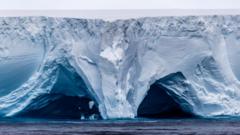In a significant environmental occurrence, the world's largest iceberg, A23a, has run aground near South Georgia after drifting for years. Initially calved from Antarctica in 1986, A23a's journey has raised concerns about the changing dynamics of polar ice and climate implications.
World's Largest Iceberg Grounded: A Call for Environmental Reflection

World's Largest Iceberg Grounded: A Call for Environmental Reflection
Massive iceberg A23a, measuring four times the size of New York City, comes to a stop off South Georgia, sparking discussions on climate change.
On March 4, 2025, A23a, the massive iceberg hailed as the largest in the world, found its resting place off the coast of South Georgia in the South Atlantic Ocean. This enormous iceberg, which is four times the size of New York City, has become a prominent landmark, albeit one that underscores potential environmental anxieties.
Born from a phenomenon known as calving, A23a broke away from its parent iceberg, A23, in 1986. For decades, it remained relatively stationary within the Weddell Sea. However, in 2020, it set off on a remarkable journey, eventually leaving Antarctic waters and making its way north.
While the risk of a Titanic-like scenario seems improbable, the grounding of A23a has reignited discussions on the lasting impacts of climate change, particularly in relation to the Antarctic ice systems. The local wildlife, especially penguins, appear to be unscathed thus far, but the potential for adverse consequences looms large as this superberg's trajectory remains a concerning illustration of our planet's evolving conditions.
Born from a phenomenon known as calving, A23a broke away from its parent iceberg, A23, in 1986. For decades, it remained relatively stationary within the Weddell Sea. However, in 2020, it set off on a remarkable journey, eventually leaving Antarctic waters and making its way north.
While the risk of a Titanic-like scenario seems improbable, the grounding of A23a has reignited discussions on the lasting impacts of climate change, particularly in relation to the Antarctic ice systems. The local wildlife, especially penguins, appear to be unscathed thus far, but the potential for adverse consequences looms large as this superberg's trajectory remains a concerning illustration of our planet's evolving conditions.







